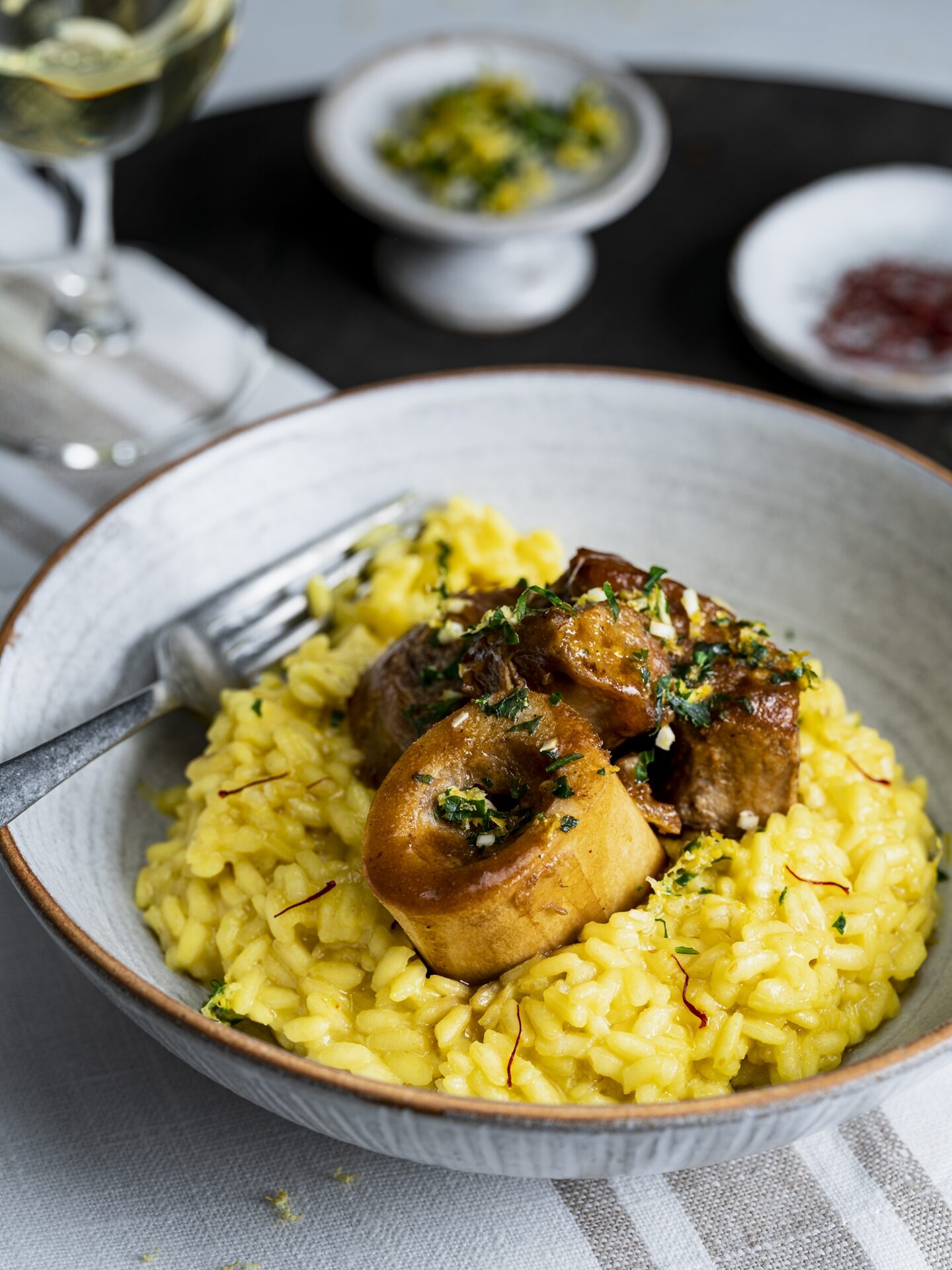Recipe: risotto and ossobuco alla Milanese
If there are two Milanese regional dishes that are often mentioned in the same breath, it is risotto alla Milanese and ossobuco alla Milanese. The creamy risotto with its warm aroma and vibrant color of saffron perfectly matches the savory flavor and tender texture of the veal shank.
Both dishes were first officially mentioned in cookbooks during the 19de century. Although, according to legend, they originated many centuries earlier. Both risotto and ossobuco are still wildly popular even beyond the borders of Italy.

Risotto alla Milanese or risotto giallo
The risotto alla Milanese is called yellow risotto because of the intense yellow color of the saffron. Use good quality saffron, it makes a big difference in color and taste.
What rice do I use for risotto?
For this dish it is best to take carnaroli rice. That short-grain rice is grown mainly in Lombardy.
Italy is Europe's largest rice producer. The Pianura Padana, the humid Po plain stretching from Piedmont to the Adriatic coast through Lombardy and Emilia-Romagna, is therefore the perfect location. In addition to carnaroli, you can find other varieties such as arborio and vialone.

What is ossobuco?
Ossobuco is really slow comfort food. You take a veal shank that you slowly stew until it almost disintegrates. The marrow in the leg creates a buttery sauce that you liven up with a spoonful of gremolata at the end.
Ask your butcher to cut your osso buco from the central part of the shank. The bone is smaller there and you will have a nicer piece of meat.
Gremolata?
Add this tangy seasoning of garlic, parsley and lemon zest to a meat or fish dish at the end. The combination of citrus, fresh herbs and spicy garlic create a perfect balance in a dish that lacks these elements after a long cooking time. In this dish, you can replace the parsley with a few leaves of rosemary, if necessary.
Recipe for a meal with 4 persons
Ingredients
For the osso buco
- 4 veal shanks
- Pepper and salt
- 100 g flour or cornmeal
- 2 tablespoons of clarified butter
- 125 ml dry white wine
- 150 ml beef stock
For the risotto
- 350 g carnaroli rice
- 1 small finely chopped onion
- 1 tablespoon of olive oil or butter
- 125 ml dry white wine
- 1.5 liters of beef broth
- 1 pinch of saffron threads or one 1/8 teaspoon of saffron powder
- 50 g grated parmesan cheese
- 1 tablespoon of butter to make the risotto creamy
- Pepper and salt
For the gremolata
- Grated zest of 1 unsprayed lemon
- 2 tablespoons parsley, chopped
- ½ clove of garlic, chopped
-
Step 1: the osso buco
First of all, you season the meat with salt and pepper. Then you pass the shanks through the flour, shake well and heat the butter in the pan. Fry the meat on both sides until golden. Now pour in the wine and let it reduce. Add another splash of the stock, cover and reduce the heat. Let the shanks stew perfectly for about 1.5 hours on a low heat. Every now and then you do need to add a little broth so the shanks don't get too dry or burn. You want to have a creamy gravy left in the pan at the end.
-
Step 2: the risotto
You start the risotto about 20 minutes before the shanks are ready.
When using saffron threads, first soak them in 2 tablespoons of beef broth.
Heat the oil or butter in a wide bowl. Sauté the onion until glazy, without coloring. Now add the rice and fry dry until lightly toasted. Deglaze with the wine and reduce. Pour in the saffron and moisten with broth until the rice is just covered. Continue adding the broth bit by bit while stirring and allow the rice to slowly absorb the liquid.
Season with salt and pepper. The rice will be al dente after about 20 minutes. Now you make the risotto creamy. In Italian this is called mantecare. You make the risotto creamy by adding the parmesan cheese and tablespoon of butter while stirring.
-
Step 3: the gremolata
Dry mix the lemon zest, parsley and garlic together.
-
Step 4: presentation
Serve the risotto in a shallow dish. On top, present the osso buco with the juice from the pan. Drizzle the gremolata over the ossobuco.
![SG 51 risotto ossobucco alla milanese]()
-
Some tips and tricks
Can I store risotto?
It is not a good idea to save risotto and reheat it. The texture of the rice changes and you get a compact mass.
Can I make risotto creamy without lactose?
Absolutely. You first use olive oil to sauté the onion and rice. Once the risotto is cooked, you can add one of the following options:
- one tablespoon of rice flour dissolved in water;
- one tablespoon of cold olive oil;
- one tablespoon of almond paste.
Can I use any broth at all?
You can just as easily use a broth made from vegetables or chicken. Make sure the broth you add to the rice is hot. That way, you avoid the temperature of the risotto dropping during the cooking process.
